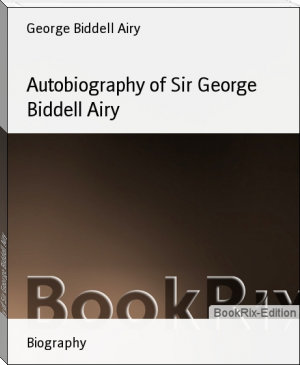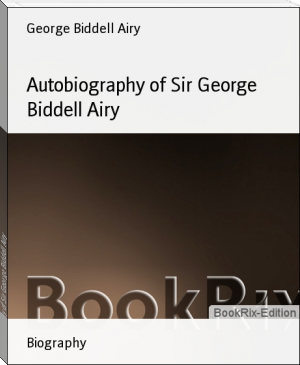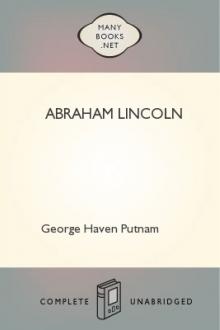Autobiography of Sir George Biddell Airy by George Biddell Airy (top 100 novels .TXT) 📕

- Author: George Biddell Airy
Book online «Autobiography of Sir George Biddell Airy by George Biddell Airy (top 100 novels .TXT) 📕». Author George Biddell Airy
received from each. The Prince recognised me and said "I am glad to see you," or something like that. Next to him stood Goulburn, and next Lord Lyndhurst, who to my great surprise spoke very civilly to me (as I will tell you afterwards). The Queen had her head bare and a sort of French white gown and looked very well. She had the ribbon of the Garter on her breast; but like a ninny I forgot to look whether she had the Garter upon her arm. The Prince wore his Garter. I went to bed dead tired and got up with a headache.--About the degree to the Prince and the other movements I will write again.
* * * * *
Here is a note from Cubitt relating to the blasting of the Round Down Cliff at Dover referred to above:
GREAT GEORGE STREET,
_Jan. 20th, 1843_.
MY DEAR SIR,
_Thursday_ next the 26th at 12 is the time fixed for the attempt to blow out the foot of the "Round Down" Cliff near Dover.
The Galvanic apparatus has been repeatedly tried in place--that is by exploding cartridges in the very chambers of the rock prepared for the powder--with the batteries at 1200 feet distance they are in full form and act admirably so that I see but little fear of failure on that head.
They have been rehearsing the explosions on the plan I most strongly recommended, that is--to fire each chamber by an independent battery and circuit and to discharge the three batteries simultaneously by signal or word of command which answers well and "no mistake."
I shall write to Sir John Herschel to-day, and remain
My dear Sir,
Very truly yours,
W. CUBITT.
G.B. Airy, Esq.
* * * * *
The following extracts are from letters to his wife written in Ireland when on his journey to consider the determination of the longitude of Valencia.
SKIBBEREEN,
_1843, July 28_.
By the bye, to shew the quiet of Ireland now, I saw in a newspaper at Cork this account. At some place through which a repeal-association was to pass (I forget its name) the repealers of the place set up a triumphal arch. The police pulled it down, and were pelted by the repealers, and one of the policemen was much bruised. O'Connell has denounced this place as a disgrace to the cause of repeal, and has moved in the full meeting that the inhabitants of this place be struck off the repeal list, with no exception but that of the parish priest who was proved to be absent. And O'Connell declares that he will not pass through this place. Now for my journey. It is a sort of half-mountain country all the way, with some bogs to refresh my eyes.
VALENCIA HOTEL,
_1843, August 6_.
It seems that my coming here has caused infinite alarm. The common people do not know what to conjecture, but have some notion that the "sappers and miners" are to build a bridge to admit the charge of cavalry into the island. An attendant of Mrs Fitzgerald expressed how strange it was that a man looking so mild and gentle could meditate such things "but never fear, Maam, those that look so mild are always the worst": then she narrated how that her husband was building some stables, but that she was demanding of him "Pat, you broth of a boy, what is the use of your building stables when these people are coming to destroy everything." I suspect that the people who saw me walking up through the storm yesterday must have thought me the prince of the powers of the air at least.
HIBERNIAN HOTEL, TRALEE,
_1843, August 7_.
I sailed from Valencia to Cahersiveen town in a sail-boat up the water (not crossing at the ferry). I had accommodated my time to the wish of the boatman, who desired to be there in time for prayers: so that I had a long waiting at Cahersiveen for the mail car. In walking through the little town, I passed the chapel (a convent chapel) to which the people were going: and really the scene was very curious. The chapel appeared to be overflowing full, and the court in front of it was full of people, some sitting on the ground, some kneeling, and some prostrate. There were also people in the street, kneeling with their faces towards the gate pillars, &c. It seemed to me that the priest and the chapel were of less use here than even in the continental churches, and I do not see why both parties should not have stopped at home. When the chapel broke up, it seemed as if the streets were crammed with people. The turnout that even a small village in Ireland produces is perfectly amazing.
1844
"In the course of 1843 I had put in hand the engraving of the drawings of the Northumberland Telescope at Cambridge Observatory, and wrote the description for letterpress. In the course of 1844 the work was completed, and the books were bound and distributed.
"The building to receive the Altazimuth Instrument was erected in the course of the year; during the construction a foreman fell into the foundation pit and broke his leg, of which accident he died. This is the only accident that I have known at the Observatory.--The Electrometer Mast and sliding frame were erected near the Magnetic Observatory.--The six-year Catalogue of 1439 stars was finished; this work had been in progress during the last few years.--In May I went to Woolwich to correct the compasses of the 'Dover,' a small iron steamer carrying mails between Dover and Ostend: this I believe was the first iron ship possessed by the Admiralty.--The Lunar Reductions were making good progress; 16 computers were employed upon them. I made application for printing them and the required sum (_L1000_) was granted by the Treasury.--In this year commenced that remarkable movement which led to the discovery of Neptune. On Feb. 13th Prof. Challis introduced Mr Adams to me by letter. On Feb. 15th I sent my observed places of Uranus, which were wanted. On June 19th I also sent places to Mr E. Bouvard.--As regards the National Standards, Mr Baily (who undertook the comparisons relating to standards of length) died soon, and Mr Sheepshanks then undertook the work.--I attended the meeting of the British Association held at York (principally in compliment to the President, Dr Peacock), and gave an oral account of my work on Irish Tides.--At the Oxford Commemoration in June, the honorary degree of D.C.L. was conferred on M. Struve and on me, and then a demand was made on each of us for _L6. 6s._ for fees. We were much disgusted and refused to pay it, and I wrote angrily to Dr Wynter, the Vice-Chancellor. The fees were ultimately paid out of the University Chest.
"In this year the longitude of Altona was determined by M. Struve for the Russian Government. For this purpose it was essential that facilities should be given for landing chronometers at Greenwich. But the consent of the customhouse authorities had first to be obtained, and this required a good deal of negotiation. Ultimately the determination was completed in the most satisfactory manner. The chronometers, forty-two in number, crossed the German Sea sixteen times. The transit observers were twice interchanged, in order to eliminate not only their Personal Equation, but also the gradual change of Personal Equation. On Sept. 30th Otto Struve formally wrote his thanks for assistance rendered.
"For the determination of the longitude of Valencia, which was carried out in this year, various methods were discussed, but the plan of sending chronometers by mail conveyance was finally approved. From London to Liverpool the chronometers were conveyed by the railways, from Liverpool to Kingstown by steamer, from Dublin to Tralee by the Mail Coaches, from Tralee to Cahersiveen by car, from Cahersiveen to Knightstown by boat, and from Knightstown to the station on the hill the box was carried like a sedan-chair. There were numerous other arrangements, and all succeeded perfectly without a failure of any kind. Thirty pocket chronometers traversed the line between Greenwich and Kingstown about twenty-two times, and that between Kingstown and Valencia twenty times. The chronometrical longitudes of Liverpool Observatory, Kingstown Station, and Valencia Station are 12m 0.05s, 24m 31.17s, 41m 23.25s; the geodetic longitudes, computed from elements which I published long ago in the Encyclopaedia Metropolitana, are 12m 0.34s, 24m 31.47s, 41m 23.06s. It appears from this that the elements to which I have alluded represent the form of the
* * * * *
Here is a note from Cubitt relating to the blasting of the Round Down Cliff at Dover referred to above:
GREAT GEORGE STREET,
_Jan. 20th, 1843_.
MY DEAR SIR,
_Thursday_ next the 26th at 12 is the time fixed for the attempt to blow out the foot of the "Round Down" Cliff near Dover.
The Galvanic apparatus has been repeatedly tried in place--that is by exploding cartridges in the very chambers of the rock prepared for the powder--with the batteries at 1200 feet distance they are in full form and act admirably so that I see but little fear of failure on that head.
They have been rehearsing the explosions on the plan I most strongly recommended, that is--to fire each chamber by an independent battery and circuit and to discharge the three batteries simultaneously by signal or word of command which answers well and "no mistake."
I shall write to Sir John Herschel to-day, and remain
My dear Sir,
Very truly yours,
W. CUBITT.
G.B. Airy, Esq.
* * * * *
The following extracts are from letters to his wife written in Ireland when on his journey to consider the determination of the longitude of Valencia.
SKIBBEREEN,
_1843, July 28_.
By the bye, to shew the quiet of Ireland now, I saw in a newspaper at Cork this account. At some place through which a repeal-association was to pass (I forget its name) the repealers of the place set up a triumphal arch. The police pulled it down, and were pelted by the repealers, and one of the policemen was much bruised. O'Connell has denounced this place as a disgrace to the cause of repeal, and has moved in the full meeting that the inhabitants of this place be struck off the repeal list, with no exception but that of the parish priest who was proved to be absent. And O'Connell declares that he will not pass through this place. Now for my journey. It is a sort of half-mountain country all the way, with some bogs to refresh my eyes.
VALENCIA HOTEL,
_1843, August 6_.
It seems that my coming here has caused infinite alarm. The common people do not know what to conjecture, but have some notion that the "sappers and miners" are to build a bridge to admit the charge of cavalry into the island. An attendant of Mrs Fitzgerald expressed how strange it was that a man looking so mild and gentle could meditate such things "but never fear, Maam, those that look so mild are always the worst": then she narrated how that her husband was building some stables, but that she was demanding of him "Pat, you broth of a boy, what is the use of your building stables when these people are coming to destroy everything." I suspect that the people who saw me walking up through the storm yesterday must have thought me the prince of the powers of the air at least.
HIBERNIAN HOTEL, TRALEE,
_1843, August 7_.
I sailed from Valencia to Cahersiveen town in a sail-boat up the water (not crossing at the ferry). I had accommodated my time to the wish of the boatman, who desired to be there in time for prayers: so that I had a long waiting at Cahersiveen for the mail car. In walking through the little town, I passed the chapel (a convent chapel) to which the people were going: and really the scene was very curious. The chapel appeared to be overflowing full, and the court in front of it was full of people, some sitting on the ground, some kneeling, and some prostrate. There were also people in the street, kneeling with their faces towards the gate pillars, &c. It seemed to me that the priest and the chapel were of less use here than even in the continental churches, and I do not see why both parties should not have stopped at home. When the chapel broke up, it seemed as if the streets were crammed with people. The turnout that even a small village in Ireland produces is perfectly amazing.
1844
"In the course of 1843 I had put in hand the engraving of the drawings of the Northumberland Telescope at Cambridge Observatory, and wrote the description for letterpress. In the course of 1844 the work was completed, and the books were bound and distributed.
"The building to receive the Altazimuth Instrument was erected in the course of the year; during the construction a foreman fell into the foundation pit and broke his leg, of which accident he died. This is the only accident that I have known at the Observatory.--The Electrometer Mast and sliding frame were erected near the Magnetic Observatory.--The six-year Catalogue of 1439 stars was finished; this work had been in progress during the last few years.--In May I went to Woolwich to correct the compasses of the 'Dover,' a small iron steamer carrying mails between Dover and Ostend: this I believe was the first iron ship possessed by the Admiralty.--The Lunar Reductions were making good progress; 16 computers were employed upon them. I made application for printing them and the required sum (_L1000_) was granted by the Treasury.--In this year commenced that remarkable movement which led to the discovery of Neptune. On Feb. 13th Prof. Challis introduced Mr Adams to me by letter. On Feb. 15th I sent my observed places of Uranus, which were wanted. On June 19th I also sent places to Mr E. Bouvard.--As regards the National Standards, Mr Baily (who undertook the comparisons relating to standards of length) died soon, and Mr Sheepshanks then undertook the work.--I attended the meeting of the British Association held at York (principally in compliment to the President, Dr Peacock), and gave an oral account of my work on Irish Tides.--At the Oxford Commemoration in June, the honorary degree of D.C.L. was conferred on M. Struve and on me, and then a demand was made on each of us for _L6. 6s._ for fees. We were much disgusted and refused to pay it, and I wrote angrily to Dr Wynter, the Vice-Chancellor. The fees were ultimately paid out of the University Chest.
"In this year the longitude of Altona was determined by M. Struve for the Russian Government. For this purpose it was essential that facilities should be given for landing chronometers at Greenwich. But the consent of the customhouse authorities had first to be obtained, and this required a good deal of negotiation. Ultimately the determination was completed in the most satisfactory manner. The chronometers, forty-two in number, crossed the German Sea sixteen times. The transit observers were twice interchanged, in order to eliminate not only their Personal Equation, but also the gradual change of Personal Equation. On Sept. 30th Otto Struve formally wrote his thanks for assistance rendered.
"For the determination of the longitude of Valencia, which was carried out in this year, various methods were discussed, but the plan of sending chronometers by mail conveyance was finally approved. From London to Liverpool the chronometers were conveyed by the railways, from Liverpool to Kingstown by steamer, from Dublin to Tralee by the Mail Coaches, from Tralee to Cahersiveen by car, from Cahersiveen to Knightstown by boat, and from Knightstown to the station on the hill the box was carried like a sedan-chair. There were numerous other arrangements, and all succeeded perfectly without a failure of any kind. Thirty pocket chronometers traversed the line between Greenwich and Kingstown about twenty-two times, and that between Kingstown and Valencia twenty times. The chronometrical longitudes of Liverpool Observatory, Kingstown Station, and Valencia Station are 12m 0.05s, 24m 31.17s, 41m 23.25s; the geodetic longitudes, computed from elements which I published long ago in the Encyclopaedia Metropolitana, are 12m 0.34s, 24m 31.47s, 41m 23.06s. It appears from this that the elements to which I have alluded represent the form of the
Free e-book «Autobiography of Sir George Biddell Airy by George Biddell Airy (top 100 novels .TXT) 📕» - read online now
Similar e-books:





Comments (0)